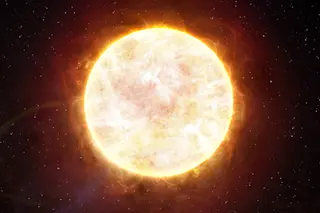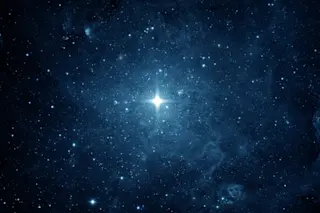Last night, my in-laws came over for dinner. As I was helping them take leftovers out to their car around 9:00, I do what I always do when I walk outside at night: I looked up. And man oh man, am I glad I did. Because this is what I saw:

Wow! [Click to refractenate.] As soon as I saw this, I ran back inside, grabbed my camera, and took this shot. The bright blob in the middle is the Moon -- it was just past half full. The "star" to the left is Jupiter, now shining brightly in the east shortly after sunset (the blue and green patches are reflections of the bright Moon inside the camera). You can also see a couple of stars in the constellation Aries just above Jupiter. But dominating the sky was the bright ring around the Moon, called the 22° halo. Halos like this are caused by ice crystals suspended in the air. The crystals are hexagonal, and light entering one face of the hexagon gets slightly bent, and then bent again as it comes out. The total angle of bending is (at least) 22°, and this is what forms the ring 22° in radius. Different colors are bent by different amounts; red is bent slightly less than blue, so the inner edge of the halo is red (look at the picture carefully and you'll see that's true). The inside of the halo is slightly darker than the sky around it, because no light is bent less than 22°. Light coming to you from the Moon inside that 22° limit gets bent away from you, so you don't see it. Light outside that limit gets bent toward you, making the bright ring. The halo is actually pretty broad, but fades rapidly outside 23 or so degrees from the Moon, so it looks like a halo. In reality it's more like a disk with a hole in it. I love how Jupiter is sitting just outside the ring; in a couple of days the Moon will swing past the giant planet in our sky, missing it by just about 4° (roughly 8 times the size of the Moon's disk itself). That'll be a lovely sight. The picture above was a ten second exposure at f/2.8 and an ISO of 400. Those are standard settings, so it can be pretty easy to take dramatic pictures of the night sky... when the subject is this beautiful. I've seen halos many, many times -- though this one was really spectacular. Still, the reason I've seen so many is quite simple: I look up. Seriously, that's all it takes. What glories of nature are you missing by not looking around you?
Related posts: - Halo, how you doin'? - Naked rainbows - Moon doggies - A sun pillar gooses the sky - Polarized rainbow, what does this mean???













